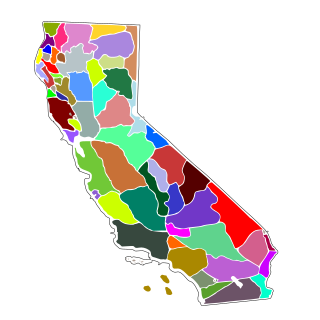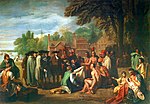Related Research Articles

The Indian Reorganization Act (IRA) of June 18, 1934, or the Wheeler–Howard Act, was U.S. federal legislation that dealt with the status of American Indians in the United States. It was the centerpiece of what has been often called the "Indian New Deal". The major goal was to reverse the traditional goal of cultural assimilation of Native Americans into American society and to strengthen, encourage and perpetuate the tribes and their historic Native American cultures in the United States.

Tribal sovereignty in the United States is the concept of the inherent authority of indigenous tribes to govern themselves within the borders of the United States. Originally, the U.S. federal government recognized American Indian tribes as independent nations, and came to policy agreements with them via treaties. As the U.S. accelerated its westward expansion, internal political pressure grew for "Indian removal", but the pace of treaty-making grew nevertheless. The Civil War forged the U.S. into a more centralized and nationalistic country, fueling a "full bore assault on tribal culture and institutions", and pressure for Native Americans to assimilate. In the Indian Appropriations Act of 1871, without any input from Native Americans, Congress prohibited any future treaties. This move was steadfastly opposed by Native Americans. Currently, the U.S. recognizes tribal nations as "domestic dependent nations" and uses its own legal system to define the relationship between the federal, state, and tribal governments.

The Nonintercourse Act is the collective name given to six statutes passed by the Congress in 1790, 1793, 1796, 1799, 1802, and 1834 to set Amerindian boundaries of reservations. The various Acts were also intended to regulate commerce between settlers and the natives. The most notable provisions of the Act regulate the inalienability of aboriginal title in the United States, a continuing source of litigation for almost 200 years. The prohibition on purchases of Indian lands without the approval of the federal government has its origins in the Royal Proclamation of 1763 and the Confederation Congress Proclamation of 1783.
Tee-Hit-Ton Indians v. United States, 348 U.S. 272 (1955), is a United States Supreme Court case involving a suit by the Tee-Hit-Ton, a subgroup of the Tlingit people. The Tee-Hit-Ton sought compensation from Congress for lumber taken from lands they occupied. The court ruled against the Tee-Hit-Ton.
Hodel v. Irving, 481 U.S. 704 (1987), is a case in which the U.S. Supreme Court held that a statute ordering the escheat of fractional interests in real property which had been bequeathed to members of the Oglala Sioux tribe was an unconstitutional taking which required just compensation.
United States v. Sandoval, 231 U.S. 28 (1913), was a United States Supreme Court case deciding whether the federal government's law prohibiting liquor on the land of Santa Clara Pueblo impermissibly infringed on the State of New Mexico's police power under the equal footing doctrine. In a unanimous decision, the Court upheld the law and Congress's ability to recognize and regulate tribes. Citing broad congressional authority in Kagama, recognition of tribes subject to the guardianship of the federal government falls on Congress, not the Court, as long as recognition is not "arbitrary" and actually reflects "distinctly Indian communities."
Menominee Tribe v. United States, 391 U.S. 404 (1968), is a case in which the Supreme Court ruled that the Menominee Indian Tribe kept their historical hunting and fishing rights even after the federal government ceased to recognize the tribe. It was a landmark decision in Native American case law.

The United States was the first jurisdiction to acknowledge the common law doctrine of aboriginal title. Native American tribes and nations establish aboriginal title by actual, continuous, and exclusive use and occupancy for a "long time." Individuals may also establish aboriginal title, if their ancestors held title as individuals. Unlike other jurisdictions, the content of aboriginal title is not limited to historical or traditional land uses. Aboriginal title may not be alienated, except to the federal government or with the approval of Congress. Aboriginal title is distinct from the lands Native Americans own in fee simple and occupy under federal trust.
County of Oneida v. Oneida Indian Nation of New York State, 470 U.S. 226 (1985), was a landmark United States Supreme Court case concerning aboriginal title in the United States. The case, sometimes referred to as Oneida II, was "the first Indian land claim case won on the basis of the Nonintercourse Act."
Seneca Nation of Indians v. Christy, 162 U.S. 283 (1896), was the first litigation of aboriginal title in the United States by a tribal plaintiff in the Supreme Court of the United States since Cherokee Nation v. Georgia (1831). It was the first such litigation by an indigenous plaintiff since Fellows v. Blacksmith (1857) and its companion case of New York ex rel. Cutler v. Dibble (1858). The New York courts held that the 1788 Phelps and Gorham Purchase did not violate the Nonintercourse Act, one of the provisions of which prohibits purchases of Indian lands without the approval of the federal government, and that the Seneca Nation of New York was barred by the state statute of limitations from challenging the transfer of title. The U.S. Supreme Court declined to review the merits of lower court ruling because of the adequate and independent state grounds doctrine.

Joint Tribal Council of the Passamaquoddy Tribe v. Morton, 528 F.2d 370, was a landmark decision regarding aboriginal title in the United States. The United States Court of Appeals for the First Circuit held that the Nonintercourse Act applied to the Passamaquoddy and Penobscot, non-federally-recognized Indian tribes, and established a trust relationship between those tribes and the federal government that the state of Maine could not terminate.

The Marshall Court (1801–1835) issued some of the earliest and most influential opinions by the Supreme Court of the United States on the status of aboriginal title in the United States, several of them written by Chief Justice John Marshall himself. However, without exception, the remarks of the Court on aboriginal title during this period are dicta. Only one indigenous litigant ever appeared before the Marshall Court, and there, Marshall dismissed the case for lack of original jurisdiction.
Confederation Congress Proclamation of 1783 was a proclamation by the Congress of the Confederation dated September 22, 1783 prohibiting the extinguishment of aboriginal title in the United States without the consent of the federal government. The policy underlying the proclamation was inaugurated by the Royal Proclamation of 1763, and continued after the ratification of the United States Constitution by the Nonintercourse Acts of 1790, 1793, 1796, 1799, 1802, and 1833.

The Narragansett land claim was one of the first litigations of aboriginal title in the United States in the wake of the U.S. Supreme Court's landmark Oneida Indian Nation of New York v. County of Oneida (1974), or Oneida I, decision. The Narragansett claimed a few thousand acres of land in and around Charlestown, Rhode Island, challenging a variety of early 19th century land transfers as violations of the Nonintercourse Act, suing both the state and private land owners.
Fellows v. Blacksmith, 60 U.S. 366 (1857), is a United States Supreme Court decision involving Native American law. John Blacksmith, a Tonawanda Seneca, sued agents of the Ogden Land Company for common law claims of trespass, assault, and battery after he was forcibly evicted from his sawmill by the Company's agents. The Court affirmed a judgement in Blacksmith's favor, notwithstanding the fact that the Seneca had executed an Indian removal treaty and the Company held the exclusive right to purchase to the land by virtue of an interstate compact ratified by Congress.

Aboriginal title in New York refers to treaties, purchases, laws and litigation associated with land titles of aboriginal peoples of New York, in particular, to dispossession of those lands by actions of European Americans. The European purchase of lands from indigenous populations dates back to the legendary Dutch purchase of Manhattan in 1626, "the most famous land transaction of all." More than any other state, New York disregarded the Confederation Congress Proclamation of 1783 and the follow-on Nonintercourse Acts, purchasing the majority of the state directly from the Iroquois nations without federal involvement or ratification.
South Carolina v. Catawba Indian Tribe, Inc., 476 U.S. 498 (1986), is an important U.S. Supreme Court precedent for aboriginal title in the United States decided in the wake of County of Oneida v. Oneida Indian Nation of New York State (1985). Distinguishing Oneida II, the Court held that federal policy did not preclude the application of a state statute of limitations to the land claim of a tribe that had been terminated, such as the Catawba tribe.

Aboriginal title in California refers to the aboriginal title land rights of the indigenous peoples of California. The state is unique in that no Native American tribe in California is the counterparty to a ratified federal treaty. Therefore, all the Indian reservations in the state were created by federal statute or executive order.
The United States Court of Appeals for the Fifth Circuit has held that there is no aboriginal title in Louisiana.

An Organic Act is a generic name for a statute used by the United States Congress to describe a territory, in anticipation of being admitted to the Union as a state. Because of Oklahoma's unique history an explanation of the Oklahoma Organic Act needs a historic perspective. In general, the Oklahoma Organic Act may be viewed as one of a series of legislative acts, from the time of Reconstruction, enacted by Congress in preparation for the creation of a unified State of Oklahoma. The Organic Act created Oklahoma Territory, and Indian Territory that were Organized incorporated territories of the United States out of the old "unorganized" Indian Territory. The Oklahoma Organic Act was one of several acts whose intent was the assimilation of the tribes in Oklahoma and Indian Territories through the elimination of tribes' communal ownership of property.
References
- David Benavides, Lawyer-Induced Partitioning of New Mexican Land Grants: An Ethical Travesty (1994).
- Herbert O. Brayer, William Blackmore: The Spanish-Mexican Land Grants in New Mexico and Colorado, 1863-1878, in A Case Study in the Economic Development of the West (1949).
- William deBuys, Fractions of Justice: A Legal and Social History of the Las Trampas Land Grant, New Mexico, 56 N.M. Hist. Rev. 71 (1981).
- Malcolm Ebright, Land Grants and Lawsuits in Northern New Mexico (1994).
- Malcolm Ebright, The Tierra Amarilla Grant: A History of Chicanery (1980).
- Christine A. Klein, Treaties of Conquest: Property Rights, Indian Treaties, and the Treaty of Guadalupe Hidalgo, 26 N.M. L. Rev. 201 (1996).
- Maria E. Montoya, Translating Property: The Maxwell Land Grant and the Conflict over Land in the American West, 1840-1900 (2002).
- Willard H. Rollings, Indian Lands and Water: The Pueblos of New Mexico (1848-1924), 6 Am. Indian. Culture & Res. J. 1 (1982).
- Victor Westphall, The Public Domain in New Mexico, 1854-1891, 33 N.M. Hist. Rev. 24 (1958).
